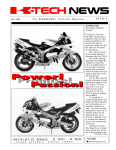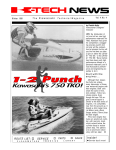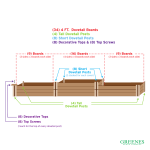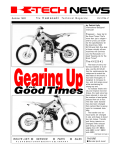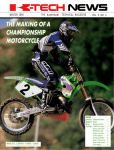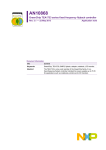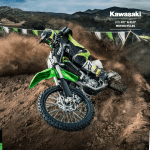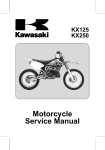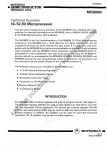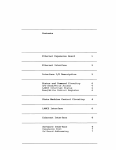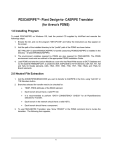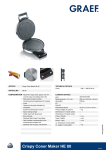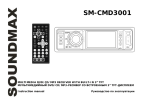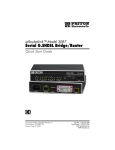Download Kawasaki KX125 / KX250 service manual 1992-1993
Transcript
Quick Reference Guide Brakes •• •• •• •• • 101 Suspension 111 General Information 1 Fuel System 2 3 Cooling System Engine Top End 4 Engine Right Side 5 Engine Removal/Installation 6 Engine Bottom End/Transmission 7 WheelslTires 8 9 Final Drive This quick reference guide will assist you in locating a desired topic or procedure. • Bend the pages back to match the black tab of the desired chapter number with the black tab on the edge at each table of contents page. • Refer to the sectional table of contents for the exact pages to locate the specific topic required. 12 • Steering 1 Electrical System 1131 Appendix 1141 Kawasaki KX125 KX250 Motorcycle Service Manual LIST OF AB BREVIATIONS A ABOC AC ATDC BBOC BOC BTDC "C DC F "F ft 9 h L ampere(s) Ib aher bottom dead center m alternating current min N after top dead center before bottom dead center bottom dead center before top dead center Pa PS psi pounds(s) meter(s) minute(s) newton(s) pascal(s) horsepower pound(s) per SQuare inch revolution degree(s) Celsius , direct current farad(s) degree(s) Fahrenheit TOC TIR top dead center total indicator reading V volt(s) W watt(s) foot, feet gram(s) hour(s) liter(s) 'pm n revolution(s) per minute ohm(s) Read OWNER'S MANUAL before operating. Foreword This manual is designed primarily for use by trained mechanics in a properly equipped shop . However, it contains enough detail and basic information to make it useful to the owner who desires to perform his own basic maintenance and repair work. A basic knowledge of mechanics, the proper use of tools, and workshop procedures must be understood in order to carry out maintenance and repair satisfactorily. Whenever the owner has insufficient experience or doubts his ability to do the work, all adjustments, maintenance. and repair should be carried out only by Qualified mechanics . In order to perform the work efficiently and to avoid costly mistakes, read the text, thoroughly familiarize yourself with the procedures before starting work. and then do the work carefully in a clean area , Whenever special tools or equipment are specified. do not use makeshih tools or equipment. Precision measurements can only be made if the proper instruments are used. and the use of substi tute tools may adversely affect safe operation . We recommend that all repairs and scheduled maintenance be performed in accordance with this service manual. To get the longest life out of your Motorcycle : • Follow the Periodic Maintenance Chart in the Service Manual. • Be alert for problems and non-scheduled maintenance . • Use proper tools and genuine Kawasaki Motorcycle parts. Special tools. gauges. and testers that are necessary when seNicing Kawasaki Motorcycles are introduced by the Special Tool Manual. Genuine pans provided as spare pans are listed in the parts Catalog . • Follow the procedures in this manual carefully. Don't take shortcuts. • Remember to keep complete records of maintenance and repair with dates and any new parts installed . How to Use this Manual In preparing this manual. we divided the product into its major systems. These systems became the manual's chapters. All information for a particular system from adjustment through disassembly and inspection is located in a single chapter. The Ouick Reference Guide shows you all of the product's system and assists in locating their chapters. Each chapter in turn has its own comprehensive Table of Contents. The Periodic Maintenance Chart is located in the General Information chapter. The chart gives a time schedule for required maintenance operations. If you want spark plug information. for example, go to the Periodic Maintenance Chart first. The chart tells you how frequently to clean and gap the plug. Next, use the Ouick Reference Guide to locate the Electrical System chapter. Then, use the Table of Contents on the first page of the chapter to find the Spark Plug section . Whenever you see these WARNING and CAUTION symbols, heed their instructions! Always follow safe operating and maintenance practices. AWARNING This warning symbol identifies special instruction , or procedures which. jf not correctly followed. could r&luh in Pfjrll(tnal injury. or loss of life . CAUTION This caution symbol identifies special instructions o r procedures which, If not strictly observed. could r8ltllt in dsmage to or destruction of equipment. This manual contains fOur more symbols (in addition to WARNING and CAUTION) which will help you distinguish different types of information. NOTE o This note symbol indicates points of particular interest mor" efficient and convenient operation. fOf • Indicates a procedural step or work to be done. 01 ndicates a procsdural sub-step or how to do the work of the procedural step it follows. It also precedes the text of 8 WARNING, CAUTION, or NOTE. * Indicates a conditional step or what action to take based on the results of the test or inspection in the procedural step or sub-step i1 follows. In most chapters an exploded view illustration of the system components foHows the Table of Contents. In these illustrations you will find the instructions indicating which parts require specified tightening torque, oil. grease or a locking agent during assembly. GENERAL INFORMATION 1 -1 General Information Table of Contents Before Servicing ................ ......................................... ............ ....................... ...1-2 Model Identification ........... .................................. ................................................1-4 General Specifications ................................................. .............................................. .1-6 Periodic Maintenance Chart .....................................................................................1-10 Torque and locking Agent ......................................... ...... ....... ............................. ...., -, 1 Special Tools. Sealant ...............................................................................................1 -14 Cable. Harness. Hose Routing ..................................................................................1 -18 1 - 2 GENERAL INFORMATION Before Servicing Before starting to service a motorcycle, careful reading of the applicable section is recommended to eliminate unnecessary work. Photographs, diagrams. notes, cautions, warnings, and detailed descriptions have been included wherever necessary. Nevertheless, even a detailed account has limitations, a certain amount of basic knowledge is also required for successful work. Especially note the following: (1) Di~ Before removal and disassembly. clean the motorcycle . Any dirt entering the eng ine or other parts will work as an abrasive and shorten the life of the motorcycle. For the same reason, before installing a new part, clean off any dust or metal filings. (2) Tightening Sequence Generally. when installing a part with several bolts, nuts, or screws, start them all in their holes and tighten them to a snug fit. Then tighten them evenly in a cross pattern. This is to avoid distortion of the part and/ or causing gas or oil leakage . Conversely when loosening the bolts, nuts, or screws, first loosen atl of them by about a quarter of turn and then remove them. Where there is a tightening sequence indication in this SelVice Manual. the botts, nuts, or screws must be tightened in the order and method indicated. (3) Torque When torque values are given in this SelVice Manual. use them . Either too little or too much torque may lead to serious damage. Use a good quality, reliable torque wrench. (4) Force Common sense should dictate how much force is necessary in assembly and disassembly. If a part seems especially difficult to remove or install, stop and examine what may be causing the problem . Whenever tapping is necessary, tap lightly using a wooden or plastic -faced mallet. Use an impact driver for screws (particularly for the removal of screws held by a locking agent) in order to avoid damaging the screw heads. (5) Edges Watch for sharp edges, especially during major engine disassembly and assembly. Protect your hands with gloves or a piece of thick cloth when lifting the engine or turning it over. (6) High - Flash Point Solvent A high-ftash point solvent is recommended to reduce fire danger. A commercial solvent commonty available in North America is Stoddard solvent (generic name) . Always follow manufacturer and container directions regarding the use of any solvent. (7) Gasket, O- Ring Do not reuse a gasket or O-ring once it has been in selVice. The mating surfaces around the gasket should be free of foreign maner and perfectly smooth to avoid oil or compression leaks. (8) Liquid Gasket. Non - Permanent Locking Agent Follow manufacturer's directions for cleaning and preparing surfaces where these compounds will be used. Apply sparingly. Excessive amounts may block engine oil passages and cause serious damage. An example of a non -permanent locking agent commonly available in North America is Loctite Lock' n Seal (Blue) . (9) Pross A part installed using a press or driver, such as a wheel bearing, should first be coated with oil on its outer or inner circumference so that it will go into place smoothly. (10) Ball Bearing and Needle Bearing Do not remove any ball or needle bearings that are pressed in unless it is necessary. If they are removed, replace them with new ones. When installing a bearing, press it in with the marked side facing out using a suitable driver until it is bottomed. Bearings should be pressed into place by pushing evenly the bearing race which is affected by friction. (11) Oil Seal and Grease Seal Replace any oil or grease seals that were removed with new ones, as removal generally damages seals. When pressing in a seal which has manufacturer's marks, press it in with the marks facing out. Seals shou ld be pressed into place using a suitable driver, which contacts evenly with the side of seal, until the face of the seal is even with the end of the hole. • GENERAL INFORMATION 1 - 3 (12) Seal Guide A seal guide is required for certain oil or grease seals during installation to avoid damage to the seal lips. Before a shaft passes through a seal, apply a linle high temperature grease on the lips to reduce rubber to metal friction . (13) Circlip, Retaining Ring Replace any circtips and retaining rings that were removed with new ones, as removal weakens and deforms them . When installing circlips and retaining rings, take care to compress or expand them only enough to install them and no more. (14) Coner Pin Replace any coner pins that were removed with new ones, as removal deforms and breaks them. (15) lubrication Engine wear is generally at its maximum while the engine is warming up and before all the fubbing surfaces have an adequate lubricative film . During assembly. oil or grease (whichever is more suitable) should be applied to any rubbing surface which has lost its lubricative film . Old grease and dirty oil should be cleaned off. Deteriorated grease has lost its lubricative quality and may contain abrasive foreign panicles. Don't use just any oil or grease. Some oils and greases in particular should be used only in cenain applications and may be harmful if used in an application for which they are not intended. This manual makes reference to molybdenum disulfide grease (MOSl ) in the assembly of cenain engine and chassis pans. Always check manufacturer recommendations before using such special lubricants. (16) Electrical Wires All the electrical wires are either single-color or two-color and. with only a few exceptions, must be connected to wires of the same color. On any of the two-color wires there is a greater amount of one color and a lesser amount of a second color, SO a two -color wire is identified by first the primary color and then the secondary color. For example, a yellow wire with thin red stripes is referred to as a ~yellow/ red " wire; it would be a Urad/yellow" wire if the colors were reversed to make red the main color. Wire (cross-section) Name of Wire Color Red Wire Strands Yellow/ Red Yellow Red (17) Replacement Pans When there is a replacement instruction, replace these parts with new ones every time they are removed . These replacement parts will be damaged or lose their original function once removed. (18) Inspection When parts have been disassembled, visua lly inspect these parts for the following conditions or other damage. It there is any doubt as to the condition of them, replace them with new ones. Abrasion Crack Hardening Warp Bent Dent Scratch Wear Color change Deterioration Seizure (19) Specifications Specification terms are defined as follows: ·Standards" : Show dimensions or performances which brand-new parts or systems have. ·Service Limits": Indicate the usable limits. If the measurement shows excessive wear or deteriorated performance, replace the damaged parts. 1-4 GENERAL INFORMATION Model Identification KX12S-J1 left Side View KX126-J1 Right Side View GENERAL INFORMATION 1-5 KX250·Jl Left Side View KX250·Jl Right Side View













